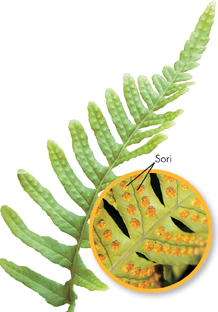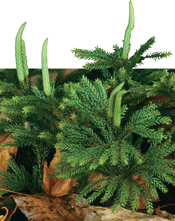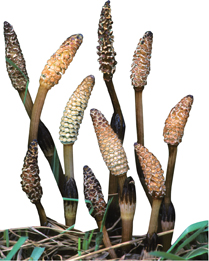Seedless Vascular Plants

KEY CHARACTERISTICS
This informal grouping lumps together all the plants that have true vascular tissue but lack seeds. Vascular tissue is a key adaptation to life on land. By carrying water and food throughout plant structures, vascular tissue permitted the evolution of roots and tree-size plants, and it allowed plants to spread into dry areas of land.
Organization Complex and specialized tissues, including true roots, stems, and leaves
Movement Adults stationary; male gametes swim to egg cells using flagella.
Water Transport Through vascular tissue
Reproduction Alternation of generations, producing spores, eggs, and swimming sperm; the sporophyte stage is dominant, but the sporophyte is not dependent on the gametophyte as it is in bryophytes.
Besides the flowering plants, these organisms make up the most diverse collection of land plants, with more than 10,000 known species.
FERNS
Ferns are common and abundant. Because they need standing water to reproduce, ferns are generally found in areas that are damp at least part of the year. The sporophyte phase of the life cycle is dominant. Spores are produced in prominent clusters known as sori (SOH ry) on the undersides of leaves.

Polypodium vulgare
CLUB MOSSES
Not really mosses, these vascular plants are also called lycopods (LY koh pahdz). These plants were especially abundant during the Carboniferous Period 360 to 290 million years ago, when they grew as large as trees. Today, their remains make up a large part of coal deposits mined for fuel.

The small club moss known as Lycopodium can be found growing on the forest floor throughout the temperate regions of North America. They look like tiny pine trees at first glance, but they are, in fact, small, seedless plants.
HORSETAILS
Only a single living genus of horsetails is known, Equisetum (ek wi SEET um). These plants were thought to resemble horses' tails; their name is derived from this perception. Today, only 25 species are known, confined to wet areas of soil. But horsetails were once much more diverse, larger in size, and abundant. Abrasive silica, found in many horsetails, was used in colonial times as a scouring powder to help clean pots and pans.

Equisetum
Table of Contents
- Formulas and Equations
- Applying Formulas and Equations
- Mean, Median, and Mode
- Estimation
- Using Measurements in Calculations
- Effects of Measurement Errors
- Accuracy
- Precision
- Comparing Accuracy and Precision
- Significant Figures
- Calculating With Significant Figures
- Scientific Notation
- Calculating With Scientific Notation
- Dimensional Analysis
- Applying Dimensional Analysis




